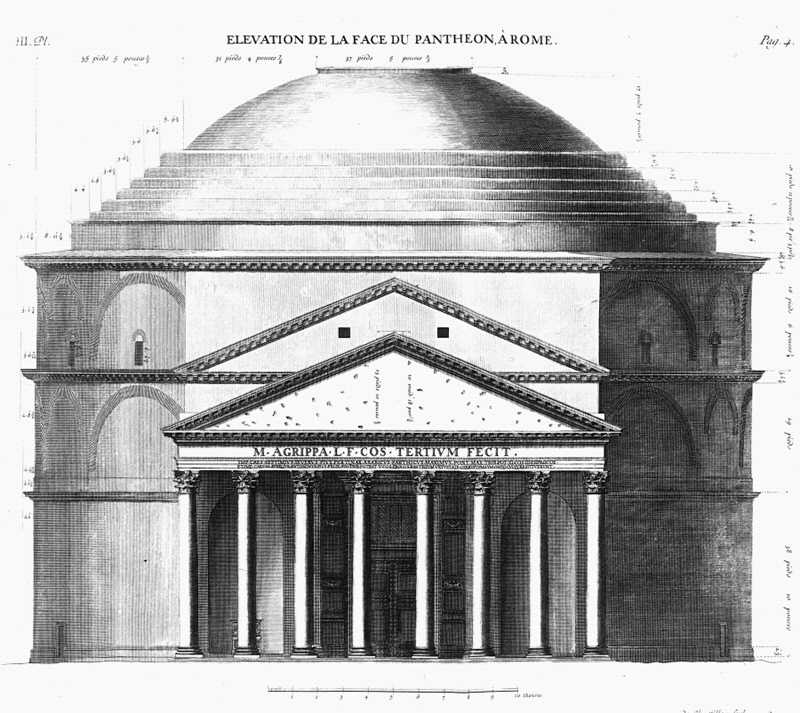The original Pantheon was built by Agrippa after the Battle of Actium in 31 BC. This building was lost in a fire, and the Pantheon that stands today was built on its location between 118 and 128 AD. Originally a Roman temple built for the worship of all gods, it was later converted into a Christian church in 609 by Pope Boniface IV, and was then converted into a memorial chapel in 1870 for the kings of Italy. It still remains a Catholic church today. Its continuous use throughout history is the reason why it is so well-preserved. Architecturally, it is defined by its large rotunda and dome, and its portico entrance. The dome has five layers of rectangular coffers that lead to a large, central oculus that lets in sunlight. The portico has eight Corinthian columns at the front, with two layers of four columns behind the front colonnade.

Public domain
The Elks National Memorial is one of many Western buildings modeled after the great Pantheon of Rome. The Pantheon's historic and architectural significance, as one of the most iconic symbols of classical architecture, has made it a popular model for buildings designed for hundreds of years. This legacy has been inscribed on the building since 1832, placed by Urban VIII. It reads: "The Pantheon, the most celebrated edifice in the whole world."
One of the most famous examples of the Pantheon's legacy is the Pantheon of Paris, finished in 1790, which kept the name and the facade of the original building, but adapted its dome with a more Parisian neoclassical style. It is just one of many Pantheon-inspired buildings found in Europe, including ones in Italy and England.
The Pantheon has also been a strong inspiration in American architecture, where it has a long history of being adapted in building designs. The Elks National Memorial may be the unique example in Chicago, but other such buildings exist throughout the States, and often in an even more blatant Pantheon style. These include Columbia University's Low Memorial Library (1895), the Killian Court Dome at MIT (1916), and the University of Virginia Rotunda (1819). These are all examples of the adaptation of the Pantheon into a university building, showing that American architects looked up to its beautiful geometric design as fittingly collegiate.
Its use in American classical architecture can also be traced to specific architects. Thomas Jefferson is the most famous of them all. The University of Virginia Rotunda was designed by him, directly inspired and closely based on the design of the Pantheon. Monticello, his plantation mansion, is loosely based on but still clearly inspired by the Pantheon. Even more inspired by the Pantheon was architect John Russell Pope, whose design for the Jefferson Memorial (1943) was a fittingly Pantheon-esque monument, for the man who himself was so enamored by its form. He also designed the Union Station for Richmond Virginia (1917), which was a looser interpretation of the dome and portico design, as well as the National Gallery of Art (1941) in Washington, DC, which bears close similarity to the original Pantheon.
Within the context of this long history of American Pantheon designs, it comes as no surprise that Egerton Swartwout chose to also adopt the famous design for the Elks Memorial. His design very clearly borrows the rotunda and dome of the Pantheon, but it does not have the same exterior qualities of the front portico; instead, it stretches the colonnade around the exterior of the building and forgoes a portico altogether. This unique design helps the Elks National Memorial stand out in comparison to all the other buildings that are inspired by the Pantheon, while still remaining clearly derived from the original design.
Just as with most other buildings inspired by the Pantheon, the Elks National Memorial has a use that does not align with the Pantheon's religious history. However, the grand and historical design does lend itself well to the aspirational goals of the Elks organization for a memorial that would be monumental, iconic, and beautiful. This is a trend among Pantheon-inspired buildings because its religious associations have always remained ambiguous, instead of being directly referenced in its architecture. As put by William MacDonald in his book on the building: "By abstracting the shape of the earth and the imagined form of the cosmos into a grand, immediately assimilated image, the architect of the Pantheon gave mankind a symbol that transcends religion, class, and political conviction" (132). The Pantheon does not immediately strike one as a religious building, but only as a beautiful one. This first impression it grants the viewer makes it the ideal inspiration for buildings of all kinds, including the Elks National Memorial.
 icons at the top right corner of the subsection.
icons at the top right corner of the subsection.